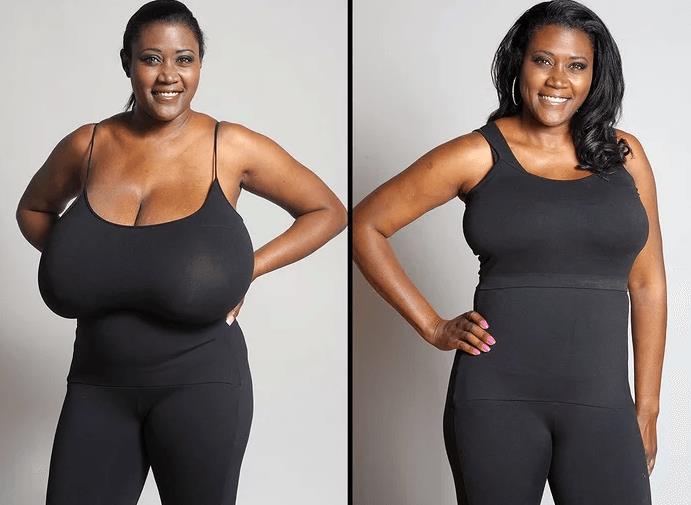Breast Reduction in Brazil
Search and Compare the Best Clinics and Doctors at the Lowest Prices for Breast Reduction in Brazil

Find the best clinics for Breast Reduction in Brazil
With Medijump you can browse 11 facilities offering Breast Reduction procedures in Brazil. The cheapest price available is $1,500 in Rio de Janeiro. And for the cheapest price globally, prices start from $89 in Czech Republic.
Breast Reduction in Rio de Janeiro
Price: $ 1,500
Breast Reduction in Araraquara
Price: $ 3,779
Czech Republic offers the best prices Worldwide
Price: $ 89
From 7 verified reviews
Regiane Mendes, 16 December 2018
Great Professionals!
From 1 verified reviews
Vyacheslav Kalaushin, 18 April 2016
One of the best Klinik.
From 17 verified reviews
Marcia Megumi, 06 July 2020
Excellent service, great results. I highly recommend it.
From 1 verified reviews
Jaquelino Shagalike, 02 September 2017
I was there to solve the problem of a wart. Dr. Rawlson called another doctor in front of me to ask what would be a good remedy for wart. Then he prescribed the medicine indicated by the other doctor and charged me for the consultation. I hope he deposited the amount in the account of the other doctor who knew what the right remedy for my problem was.
Instituto Braga, can be found in R Para, Sao Paulo, Brazil and offers its patients Breast Reduction procedures as well as 29 other procedures, across 1 different procedure categories. The price of a Breast Reduction procedure starts from just ฿172,000, and the average price is around ฿119,676. Many medical professionals work at the Clinic, with 4 in total, and Instituto Braga is accredited by just one known accreditations institute, The American Society for Aesthetic Plastic Surgery
Dra Carla Iaconelli, can be found in R Para, Sao Paulo, Brazil and offers its patients Breast Reduction procedures as well as 111 other procedures, across 2 different procedure categories. At present, there is no pricing information for Breast Reduction procedures at Dra Carla Iaconelli. The pricing information is quite specialised, so it's only available on request, and the average price is around $3,326. The lead specialist at the Hospital will be carrying out all the treatments, and Dra Carla Iaconelli has several accreditations, including: FEBRASGO - Federação Brasileira das Associações de Ginecologia e ObstetríciaSBRA - Sociedade Brasileira de Reprodução Assistida
From 2 verified reviews
Talita Gonçalves, 01 May 2019
Wonderful love my surgery I did lipo abdominoplasty and the buttock augmentation was beautiful the surgery all my friends praise dr marco perfect 😍
From 11 verified reviews
Fernando Schuler, 11 December 2018
Professionalism is the word that sums up this clinic and its collaborators.
Dr. Sylverson Porto Rassi, can be found in Av Pedro Galeazi, Araraquara, Brazil and offers its patients Breast Reduction procedures as well as 11 other procedures, across 4 different procedure categories. At present, there is no pricing information for Breast Reduction procedures at Dr. Sylverson Porto Rassi. The pricing information is quite specialised, so it's only available on request, and the average price is around $3,326. The lead specialist at the Hospital will be carrying out all the treatments, and Dr. Sylverson Porto Rassi is accredited by just one known accreditations institute, SBCP - Sociedade Brasileira de Cirurgia Plástica
CosmeticVacations, can be found in R Real Grandeza, Rio de Janeiro, Brazil and offers its patients Breast Reduction procedures as well as 64 other procedures, across 7 different procedure categories. At present, there is no pricing information for Breast Reduction procedures at CosmeticVacations. The pricing information is quite specialised, so it's only available on request, and the average price is around $3,326. The lead specialist at the Hospital will be carrying out all the treatments, and CosmeticVacations has several accreditations, including: ASPS - American Society of Plastic SurgeonsSBCP - Sociedade Brasileira de Cirurgia PlásticaSBD - Sociedade Brasileira de DermatologiaSBCD - Sociedade Brasileira de Cirurgia DermatológicaAEXPI - Associação dos Ex-alunos do Professor Ivo PitanguyCBA - Consórcio Brasileiro de AcreditaçãoSBA - Sociedade Brasileira de AnestesiologiaSBCM - Sociedade Brasileira de Cirurgia da MãoSBU - Sociedade Brasileira de Urologia
Consultório de Cirurgia Plástica, can be found in Av Sen Souza Naves, Curitiba, Brazil and offers its patients Breast Reduction procedures as well as 19 other procedures, across 2 different procedure categories. At present, there is no pricing information for Breast Reduction procedures at Consultório de Cirurgia Plástica. The pricing information is quite specialised, so it's only available on request, and the average price is around $3,326. The lead specialist at the Hospital will be carrying out all the treatments, and Consultório de Cirurgia Plástica is accredited by just one known accreditations institute, SBCP - Sociedade Brasileira de Cirurgia Plástica
- Home
- Brazil
Compare Before & After Photos of _procedure_photos.phpBreast Reduction


Front view


Front view


Front view


Front view


Front view


Front view
WHY US?
At Medijump, we're making medical easy. You can search, compare, discuss, and book your medical all in one place. We open the door to the best medical providers worldwide, saving you time and energy along the way, and it's all for FREE, no hidden fees, and no price markups guaranteed. So what are you waiting for?

Free

Best Price

Widest Selection

Risk-Free
What you need to know about Breast Reduction in Brazil

Female Breast reduction (reduction mammoplasty), also known as Reduction Mammoplasty, is a surgical operation to reduce the weight and volume of the breasts. During the procedure, fat, glandular tissue and skin are removed from the breasts, which are then reshaped, and the nipples repositioned. The nipple-areola complex (NAC) is preserved to ensure that lactational ability is not affected. The mammoplasty is performed for three reasons, aesthetic, physical and psychological.
Breast size is determined by genes, hormones, body frame, and weight. For most women, breast size is proportionate to the body, but for some, the breasts are particularly large. Large breasts can cause physical symptoms such as discomfort, backache, neck pain, and skin irritations. Oversized breasts can also cause psychological distress. Common complaints from women with large breasts include not being able to wear fashionable clothes and finding it difficult to take part in active sports. In these cases, breast reduction surgery can be an option.
What does a Breast Reduction Procedure Involve?
The procedure begins with making you lay in the supine position. Anesthesia is given to avoid pain during surgery. The area is sterilized and an incision is given around the areola and down your breasts. The flap of skin containing areola and nipple is displaced and excessive fat, breast tissue, and skin are removed to lessen the size of your mammary gland. In the next step, breasts are reshaped, areola and nipples are again placed over the reduced breasts and stitches are given.
In some cases, when a large amount of tissue and fat is removed, skin flap with areola and nipples is detached and repositioned at a higher level according to the new size. Drainage tubes are inserted into the breasts to drain away blood and fluid. Bandages are applied over the stitched incisions. You are asked to wear a surgical bra. It is tried to make both breasts look alike; however, small variations in the size of breasts and areola can be there.
What about Breast Augmentation?
Breast augmentation might also be performed on women who suffer from a condition called macromastia. It can be due to various reasons such as hypertrophy of adipose tissue in the breast, after menopause, postpartum, genetics, etc. In this condition, your breasts are sagging, and their size is bigger in proportion to your body, causing a number of problems. A woman affected by macromastia suffers from pain in the head, neck, shoulders, and back. Blood circulation and respiration are also disturbed. Men who experience gynecomastia can also opt for breast reduction surgery.
Another case where breast reduction can be an option is when breasts grow particularly large because of the use of hormone replacement therapy (HRT).
What is the cost of Breast Reduction in Brazil?
It's crucial to bear in mind that Breast Reduction is a substantial procedure. Consequently, contemplating the expense of this process within Brazil is critical. While the total cost might fluctuate based on individual circumstances and the intricacy of the operation, it typically includes the cost of anesthesia, hospital expenses, surgical equipment, and the surgeon's charge. Having a comprehensive understanding of the total price is critical to make an educated decision and align your financial planning accordingly.
Numerous factors could influence the expense of a Breast Reduction in Brazil. This includes the skill level of the surgeon, the complexity of the procedure, the kind of anesthesia applied, and postoperative care services. Thorough research and careful financial planning should enable you to handle the costs associated with the process. Also, if needed, you could consider alternatives for financial aid or insurance cover.
How Long Should I Stay in Brazil for a Breast Reduction Procedure?
Surgery can last between 2 to 5 hours and sometimes even longer depending upon the size of your breasts and amount of fat and tissue that is to be removed - an overnight stay as an inpatient is required. After your condition is monitored, you are discharged from the hospital. You have to stay for at least 14 days in Brazil for follow up procedures. Regular check-ups are advised in the first few days after surgery. Oral pain killers are given to deal with pain and swelling. Stitches are removed in 2 weeks after which you are allowed to go home. In case you notice any redness, secretion, abnormal pain or inflammation, consult your doctor.
What's the Recovery Time for Breast Reduction Procedures in Brazil?
It takes several months for recovery from a breast reduction surgery. You cannot go to work for 1 to 2 weeks after the surgery. There will be pain and swelling in the initial days for which you are given some medicines. Avoid intensive physical activity for at least 1 month. You are asked not to wear underwire bras for a few months. You are allowed to wear a normal bra after 4 weeks. It takes 6 to 8 weeks for the swelling and tenderness to go away. Even after complete recovery, scars do not disappear. However, they are faded and become less visible. Changes continue to take place for a year after going through this surgery.
What sort of Aftercare is Required for Breast Reduction Procedures in Brazil?
You should consider the following points to take care of yourself after surgery:
- Do come for regular check-ups.
- Take your medicines regularly, as and when prescribed by your physician.
- Make sure that someone lives with you to look after you.
- Follow a healthy diet plan for a better recovery.
- Do not wear fancy, underwire bras in the early days. Wear surgical bra only.
- Wear loose clothes, tees, and shirts.
- Avoid excessive, unnecessary movement of your breasts.
- Do not take a bath in the first few days, a wet bandage can be the cause of infection.
- Do not ignore any kind of soreness, redness or abnormal secretions from your breasts. Visit your doctor immediately.
- Drink plenty of water. It is very effective for a quick recovery.
- Use icepacks to help you with swelling.
- Do not try to lift heavy objects because your movement is restricted due to stitches. It can open up your stitches before time.
- Do some stretching exercises when told by your physician.
What's the Success Rate of Breast Reduction Procedures in Brazil?
Breast reduction mammoplasty is found to be successful in most of the cases. According to a survey, 80% of women are satisfied with the results of the surgery. This effectively reduces neck pain, back pain, headache, and shoulder pain, with your breasts no longer sagging and causing these problems. Respiratory and circulatory problems are also resolved. In case this surgery is not successful, it leaves prominent scars which can be subjected to hypertrophy. There might be less than the required amount of tissue and fat removal. Sometimes, more breast tissue is removed leaving your chest flat. A secondary breast reduction surgery is performed to cope with this.
For an in-depth and personal review of the pros and cons of Breast Reduction, including before and after shots, watch this video blog.
Are there Alternatives to Breast Reduction Procedures in Brazil?
Following are some alternatives to reduce your breast size without going through a surgery:
- Weight Loss: losing weight can also be effective in the case of reducing breast size. Some exercises are there to help you decrease your size. Exercise removes excess adipose tissue making your breasts smaller.
- Liposuction: it is a less invasive method in which a small incision is given to insert a cannula and fat is sucked from it reducing breast size. There are least scarring and recovery is faster.
- Fitting bra: it is not a permanent method to reduce your breast size but a specialized fitting bra can be helpful in making your breasts look smaller. It is not a standard bra.
What Should You Expect Before and After the Procedure
Knowing what to expect before and during a Breast Reduction helps you prepare physically, intellectually, and emotionally for the experience. A comprehensive health examination is scheduled before the procedure. Along with preparing for the procedure by following the pre-surgery instructions supplied by your healthcare institution, this is also your chance to discuss your hopes and concerns with the surgeon. Your food routine, medication regimen, and lifestyle practises might need to change as a result of this preparation.
After the surgery, it's common to feel some soreness, inflammation, and sometimes even bruising. All of these symptoms can be treated with the right medication. It's important to unwind, refrain from strenuous activity for a few weeks, wear a bra with a specific purpose, and follow a specific wound care regimen.
What are Potential Risks of Breast Reduction?
The Breast Reduction, similar to any other surgical procedure, poses possible risks and complications such as infection, bleeding, altered sensation in the nipple or breast due to anesthesia, and difficulties in breastfeeding post-operation. It is imperative to have a detailed discussion about these potential issues with your healthcare professional at the consultation phase.
It's important to know that the probability of these risks occurring is minimal and can be reduced further by opting for a well-respected clinic and surgeon, following the pre-surgical instructions, and adhering to the aftercare routine provided.
Whilst the information presented here has been accurately sourced and verified by a medical professional for its accuracy, it is still advised to consult with your doctor before pursuing a medical treatment at one of the listed medical providers
No Time?
Tell us what you're looking for and we'll reachout to the top clinics all at once
Enquire Now

Popular Procedures in Brazil
Prices Start From $85

Prices Start From $120

Prices Start From $692

Prices Start From $236

Recommended Medical Centers in Brazil for Breast Reduction

- Interpreter services
- Translation service
- Religious facilities
- Medical records transfer
- Medical travel insurance
- Health insurance coordination
- TV in the room
- Safe in the room
- Phone in the room
- Private rooms for patients available

- Interpreter services
- Translation service
- Religious facilities
- Medical records transfer
- Medical travel insurance
- Health insurance coordination
- TV in the room
- Safe in the room
- Phone in the room
- Private rooms for patients available

- Interpreter services
- Translation service
- Religious facilities
- Medical records transfer
- Medical travel insurance
- Health insurance coordination
- TV in the room
- Safe in the room
- Phone in the room
- Private rooms for patients available

- Interpreter services
- Translation service
- Religious facilities
- Medical records transfer
- Medical travel insurance
- Health insurance coordination
- TV in the room
- Safe in the room
- Phone in the room
- Private rooms for patients available

- Interpreter services
- Translation service
- Religious facilities
- Medical records transfer
- Medical travel insurance
- Health insurance coordination
- TV in the room
- Safe in the room
- Phone in the room
- Private rooms for patients available

- Interpreter services
- Translation service
- Religious facilities
- Medical records transfer
- Medical travel insurance
- Health insurance coordination
- TV in the room
- Safe in the room
- Phone in the room
- Private rooms for patients available

- Interpreter services
- Translation service
- Religious facilities
- Medical records transfer
- Medical travel insurance
- Health insurance coordination
- TV in the room
- Safe in the room
- Phone in the room
- Private rooms for patients available

- Interpreter services
- Translation service
- Religious facilities
- Medical records transfer
- Medical travel insurance
- Health insurance coordination
- TV in the room
- Safe in the room
- Phone in the room
- Private rooms for patients available

- Interpreter services
- Translation service
- Religious facilities
- Medical records transfer
- Medical travel insurance
- Health insurance coordination
- TV in the room
- Safe in the room
- Phone in the room
- Private rooms for patients available

- Interpreter services
- Translation service
- Religious facilities
- Medical records transfer
- Medical travel insurance
- Health insurance coordination
- TV in the room
- Safe in the room
- Phone in the room
- Private rooms for patients available
Breast Reduction in and around Brazil
About Brazil
Occupying the title of the largest country in South America, Brazil embraces a diverse population of over 209 million people. The nation is globally renowned for its passion for football (also referred to as soccer in some parts of the world) and their dynamic, flamboyant carnival traditions, boasting a vibrant mix of music, dance, and colorful attire.
In addition to its vivacious culture, Brazil is a sanctuary of spectacular natural beauty. The country nurtures some of the world's most stunning natural wonders, including the dramatic Iguacu Falls and the world's largest tropical rainforest, the Amazon Rainforest, teeming with diverse plant and animal species. One can't miss the landmark figurine of Christ the Redeemer in Rio de Janeiro that towers 98-feet high, becoming a symbol of Brazil's deep-rooted religious faith and an iconic sight that captures hearts worldwide.
Brazil offers more than 60 JCI-accredited facilities and is one of the leading destinations in the world for cosmetic surgery, with Breast Reduction procedures being especially popular. Doctors are often Western-trained and speak English on top of Portuguese and Spanish. Local accreditations include the Consortium of Brazilian Accreditation and the Brazilian Hospital Medical Quality Organization (ONA). Popular locations within Brazil include the capital Brasilia, Rio de Janeiro, Sao Paulo, and Curitiba.
Popular Parts of Brazil
- Rio de Janeiro is a combination of natural attractions and metropolis. It is known to be a party city that offers good times and an unforgettable experience. Lounge around in the world-famous beaches of Ipanema and Copacabana, sample Brazilian cuisine, hike the summit of Corcovado and see the high statue of Christ the Redeemer, dance in Rio Carnival, and see the spectacular views of Ipanema and Guanabara Bay from the Sugarloaf Mountain.
- São Paulo is the largest city in Brazil. It is a huge city that at first glance seems intimidating. It offers hundreds of museums, quirky urban art, delicious cuisine, lively nightlife, and intense cultural experience. Visit Avenida Paulista (Paulista Avenue), a street filled with shopping centers, parks, bars, restaurants, museums, theatres, and cultural spaces.
- Salvador is full of vibrant cultures. It is the heart of Brazil’s Afro-Brazilian community. The city’s charm lies in its pastel-colored neighborhood, centuries-old architecture, and freshly-cooked acarajé and completed with wild festivals and capoeira circles every night.
- Brasília is Brazil’s capital. It’s very modern with futuristic architecture that looks more like artworks than ordinary buildings. It’s a paradise for architecture buffs. Besides the architecture, the food and nightlife in this city is something that should not be missed.
- Manaus might be isolated in terms of location, but it’s actually a large city with a prospering industry and a rich culture. The city is also filled with natural beauty; green spaces, waterfalls, and ecological parks surround its colonial buildings. It is the gateway to the Amazon Rainforest.
Weather and Climate in Brazil
As a large country, the weather in Brazil varies from tropical in the north to temperate in the south. A large part of the country lies in the topics. Brazil is a year-round destination because it has a steady average annual temperature. The temperature rarely drops below 20 °C.
Winter in Brazil starts in May and ends in September. The weather remains tropical in the north with an average temperature ranging between 20 °C to 30 °C. In Rio de Janeiro, the temperature varies between 14 °C to 25 °C. However, the evenings usually feel a lot colder.
During this particular season, one can expect a fair amount of rainfall in Rio, leading to many wet and rain-soaked days. If you plan a visit at this time, it's wise to keep that in mind and prepare accordingly. In contrast, further inland, São Paulo experiences significantly cooler temperatures compared to Rio, reflecting the country's vast geographical expanse and diverse microclimates spread across its regions.
This temperature drop might require some warm clothing, especially during late evenings and nights. So, whether you wish to enjoy the rainy murmur in Rio or seek the cool retreat of São Paulo, there's something unique for every traveler in Brazil during this season.
The temperature in Rio rise between November and March, with the highest temperature of around 40 °C but with a thermal sensation of around 50 °C. The Rain rarely lasts long during these months. In the north of Brazil, the rainy season starts in December. March and May see the heaviest rainfall. It’s hot and humid with frequent rain throughout the year in the Amazon.
Getting Around in Brazil
The most popular international airports are Rio de Janeiro–Antonio Carlos Jobim International Airport (popularly known as Galeão International Airport) and São Paulo/Guarulhos–Governador André Franco Montoro International Airport. Both airports serve domestic and international flights to many cities around the globe. The airports mainly serve major airlines but there are budget airlines such as Norwegian Air UK. Tourists can take taxis, bus, train, or car rental from both airports to the city centers.
Brazil is really big, so there will be a lot of long-distance travel to get around the country. The easiest and fastest way to get from one city to another is by domestic flights. The only downside is that the tickets are very expensive. LATAM and GOL Airlines offer multi-trip tickets or air pass. The most economical option is to buy an air pass if you plan to visit a number of different cities.
Buses are popular in Brazil, servicing most areas of the country. The bus system is excellent and provides a comfortable and economical way of travel. Be aware that the distance can be really tiring and overwhelming; some trips can take over 40 hours. The buses are operated by hundreds of different private companies, but the price is standardized. The fare varies from 75 BRL to 240 BRL. There are luxurious buses too.
A good way to get around major cities like São Paulo and Rio is to use Brazil Metro (subway). The fares are around 3.50 BRL to 3.80 BRL. You can purchase rechargeable travel cards. The metro does not operate at night. Be sure to watch your belongings at all times when traveling on the metro.
Taxis run on a metered system, but if you travel a bit further out of town, you need to negotiate the price with the driver. It is best to phone for a taxi or pick one up at a taxi station and make sure to get into a licensed taxi. Ferries and other water travel are important in many parts of Brazil.
Tourist Visas in Brazil
Nationals of 72 countries and territories can enter and stay in Brazil for up to 90 days without a visa. In some cases, an identity document may be accepted instead of a passport. Citizens of other countries, including China and India, must apply for and obtain a visa before entering Brazil. It is recommended to contact the nearest Brazilian embassy or consulate for the most up-to-date visa information.
Brazil offers an electronic visa (e-Visa) for citizens of eligible countries. The e-Visa is valid for two years and allows multiple entries for stays of up to 90 days per year. Applicants can apply for the e-Visa online through the Brazilian government's website.
Additional Information
- Local Currency: The official currency is the Brazilian Real (BRL). 1 USD will get you approximately 5.04 BRL.
- Money & Payments: ATMs are widely available in Brazil and it is the easiest way of getting cash in big cities. ATMs in smaller towns usually don’t work for non-Brazilian cards. Credit cards (Visa and MasterCard) are accepted in numerous shops, restaurants, and hotels. It might be handy to always have cash with you, but always be extremely cautious. Tipping is optional for housekeepers, tip parking assistants 2 BRL, or more since they do not receive wages and depend on tips. Taxis do not expect tips. Restaurants usually include a 10% service charge in the bill.
- Local Language: The official language is Portuguese. English is not widely spoken, especially outside Rio and São Paulo.
- Local Culture and Religion: The largest religion in Brazil is Christianity with more than 60% of the population follows Roman Catholicism.
- Public Holidays: Brazil celebrates major Christian religious holidays as well as Independence Day and Civil Servants Day. Festa Junina, Parintins Folklore Festival, and Oktoberfest are three of the biggest annual festival in the country.
Popular Searches
- Plastic Surgery in Thailand
- Dental Implants in Thailand
- Hair Transplant in Thailand
- Breast Augmentation Thailand
- Gastric Sleeve in Thailand
- Gender Reassignment Surgery in Thailand
- Laser Hair Removal in Bangkok
- Botox in Bangkok
- Dermatology in Bangkok
- Breast Augmentation in Bangkok
- Coolsculpting in Bangkok
- Veneers in Turkey
- Hair Transplant in Turkey
- Rhinoplasty in Turkey
- Stem Cell Therapy in Mexico
- Rhinoplasty in Mexico
- Liposuction in Mexico
- Coolsculpting in Tijuana
- Rhinoplasty in Korea
- Scar Removal in Korea
- Gastric Sleeve in Turkey
- Bone Marrow Transplant in India
- Invisalign in Malaysia
- Plastic Surgery in the Dominican Republic
- Tummy Tuck in the Dominican Republic
- Plastic and Cosmetic Surgery in Poland
- Rhinoplasty in Poland
- Hair Implant in Poland
- Dental Implants in Poland
- IVF in Turkey









